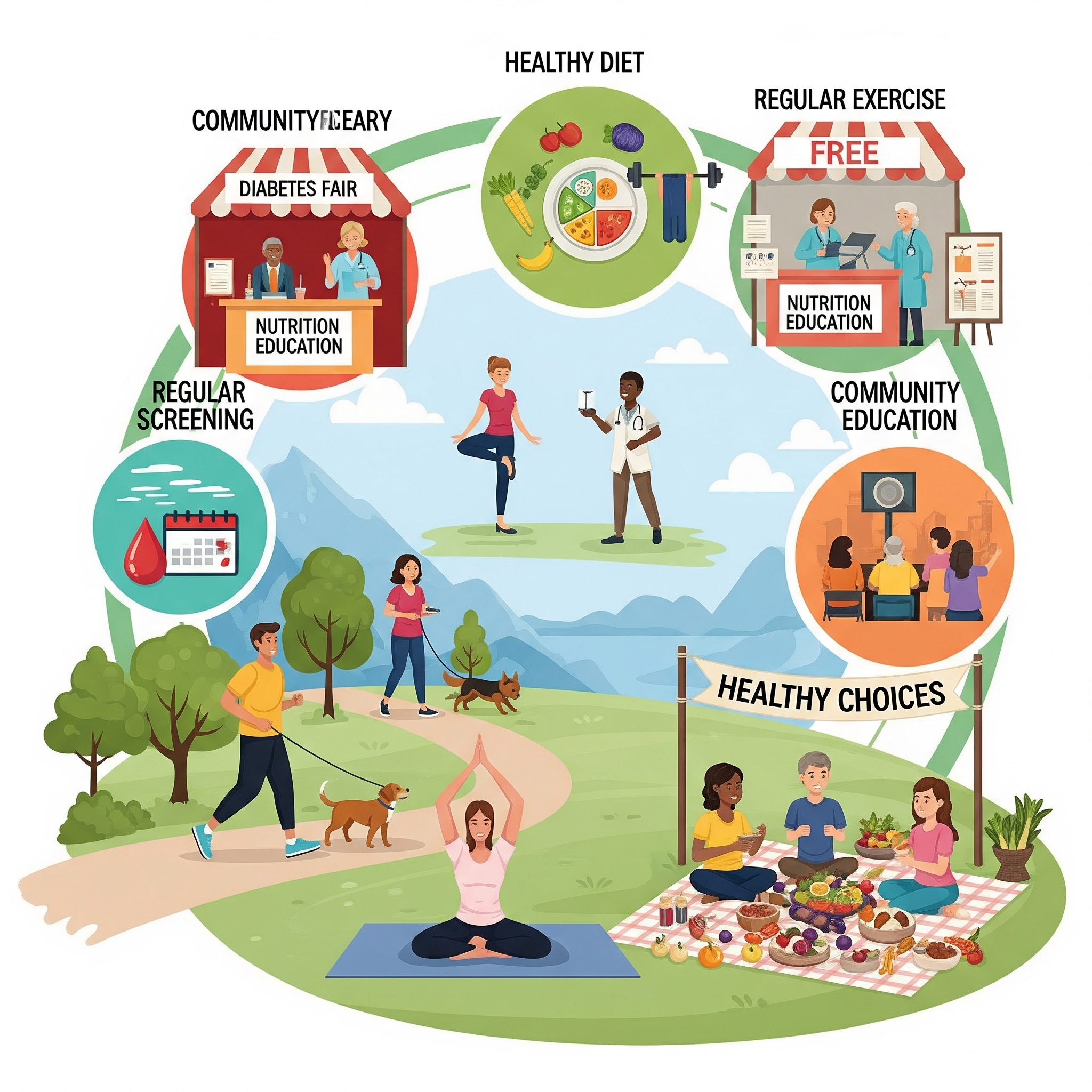Key Highlights
- India houses 101 million diabetics and 136 million prediabetics according to ICMR-INDIAB 2023 study, making it the global diabetes capital with 11.4% adult prevalence
- Urban-rural divide shows 16.4% urban versus 8.9% rural prevalence driven by lifestyle changes, processed food consumption, and sedentary occupations in cities
- Economic burden consumes 2.1% of GDP annually with 38% of diabetic households facing catastrophic expenditure and 58% spending going to medicines
- NPCDCS program established 682 District NCD Clinics and trained over 7 lakh health workers, achieving screening of 1.29 crore people through institutional framework
- Unique “thin-fat” phenotype affects 43.3% population showing diabetes development at lower BMI levels compared to Western populations due to genetic predisposition
India stands at the epicenter of a global health crisis that threatens to undermine decades of economic progress and social development. The Indian Council of Medical Research-India Diabetes (ICMR-INDIAB) 2023 study reveals a staggering reality: 101 million Indians live with diabetes while an additional 136 million are prediabetic, collectively representing 11.4% of the adult population. This unprecedented burden has rightfully earned India the unenviable title of “Diabetes Capital of the World,” where every ninth adult battles this chronic condition that silently ravages communities across urban centers and rural heartlands alike. pmc.ncbi.nlm.nhi
Epidemiological Landscape: The Scale of India’s Diabetes Crisis
National Prevalence and Demographic Patterns
The ICMR-INDIAB study, covering all 28 states, two union territories, and the National Capital Territory of Delhi, represents the most comprehensive diabetes assessment ever undertaken in India. The findings paint a sobering picture of a nation grappling with an escalating metabolic health crisis. thelancet
Current Diabetes Statistics (2023):
- Total diabetics: 101 million (11.4% of adult population)
- Prediabetics: 136 million (15.3% of population)
- Undiagnosed cases: Approximately 57% of diabetics remain unaware of their condition
- National healthcare expenditure: $92 per diabetic annually
- Annual diabetes-related deaths: Over 1 million bbc
Urban-Rural Disparity: The Great Divide
One of the most striking findings from recent epidemiological studies is the dramatic urban-rural gap in diabetes prevalence, reflecting India’s rapid socioeconomic transformation and lifestyle transitions. diabetesasia
Geographic Prevalence Patterns:
- Urban areas: 16.4% prevalence – nearly double the rural rate
- Rural areas: 8.9% prevalence but still representing millions of affected individuals
- Regional variations: Southern and Western states show highest burden
- State-specific data: Tamil Nadu leads with 25.5% prevalence, while northeastern states show lower rates
Contributing Factors to Urban-Rural Divide:
- Lifestyle differences: Urban populations face sedentary occupations, processed food consumption
- Economic factors: Higher disposable income enabling calorie-dense diets in cities
- Healthcare access: Better diagnostic facilities in urban areas leading to higher detection rates
- Environmental factors: Air pollution and urban stress contributing to metabolic dysfunction
The “Thin-Fat” Phenotype: India’s Unique Challenge
A particularly concerning aspect of India’s diabetes epidemic is the emergence of the “thin-fat” phenotype – individuals appearing thin by conventional anthropometric standards yet harboring excess visceral adiposity and elevated diabetes risk.
Phenotype Characteristics:
- 43.3% of India’s population exhibits thin-fat characteristics
- Higher rural prevalence (46%) compared to urban areas (39.6%)
- Diabetes development at lower BMI levels compared to Western populations
- Genetic predisposition: South Asians show greater insulin resistance at lower body weights
Root Causes: Understanding the Diabetes Surge
Lifestyle and Dietary Transformations
India’s economic liberalization since the 1990s has fundamentally altered dietary patterns and physical activity levels, creating ideal conditions for diabetes proliferation. japi
Dietary Changes:
- Increased processed food consumption: High-calorie, low-nutrient foods becoming staples
- Traditional diet erosion: Reduced consumption of millets, whole grains, and traditional foods
- Sugar-sweetened beverages: Rising consumption among youth and urban populations
- Cooking oil changes: Shift from traditional oils to refined, high-omega-6 alternatives
Physical Activity Decline:
- Sedentary occupations: IT and service sector growth reducing physical activity
- Urban transportation: Reduced walking and cycling in favor of motorized transport
- Recreation patterns: Screen-based entertainment replacing outdoor activities
- Infrastructure constraints: Limited safe spaces for physical activity in urban areas
Socioeconomic and Environmental Factors
Urbanization Impact:
- Air pollution: Particulate matter contributing to insulin resistance and metabolic dysfunction
- Stress factors: Urban living stress affecting cortisol levels and glucose metabolism
- Food environment: Proliferation of fast food outlets and processed food availability
- Sleep disruption: Urban lifestyle patterns affecting circadian rhythms
Genetic Predisposition:
- South Asian susceptibility: Higher genetic risk for insulin resistance and diabetes
- Thrifty gene hypothesis: Evolutionary adaptation to food scarcity becoming maladaptive in abundance
- Epigenetic factors: Environmental influences affecting gene expression across generations
Health and Economic Consequences: The Multifaceted Burden
Direct Health Impact
Diabetes serves as a gateway to multiple complications, creating cascading health crises that overwhelm healthcare systems and devastate families.
Major Complications:
- Cardiovascular disease: 2-4 times higher risk of heart attacks and strokes
- Diabetic nephropathy: Leading cause of kidney failure requiring dialysis
- Diabetic retinopathy: Primary cause of preventable blindness
- Diabetic neuropathy: Causing pain, disability, and increased amputation risk
- Mental health: Bidirectional relationship with depression and anxiety disorders
Economic Burden: The Hidden Cost Crisis
The economic impact of diabetes extends far beyond direct medical costs, creating a comprehensive drain on national resources and individual finances.
Direct Medical Costs:
- Out-of-pocket expenditure: 48.5% of households use distressed financing for diabetes care
- Catastrophic spending: 38% of diabetic households experience catastrophic health expenditure
- Medicine costs: Constitute 58% of out-of-pocket expenses for diabetes care
- Hospitalization costs: Average monthly expenditure 4.5 times higher in private facilities
Indirect Economic Impact:
- GDP loss: Estimated 2.1% of India’s GDP lost annually to diabetes and NCDs
- Productivity reduction: Working-age diabetes affecting prime productive years
- Poverty induction: 10% of diabetic households pushed below poverty line due to healthcare costs
- Workforce impact: Premature mortality affecting economic productivity
Comparative Economic Burden:
International studies reveal India’s unique challenges: drug costs represent 58% of diabetes expenses compared to 6.2-12% in Western countries, highlighting healthcare system inadequacies and insurance coverage gaps.
Policy Framework and Institutional Response
National Programme for Prevention and Control of Cancer, Diabetes, Cardiovascular Diseases and Stroke (NPCDCS)
Launched in 2010, the NPCDCS represents India’s primary institutional response to the NCD epidemic, focusing on prevention, early detection, and management of diabetes and related conditions.
Infrastructure Development:
- 682 District NCD Clinics established nationwide
- 191 District Cardiac Care Units for emergency cardiac care
- 5,408 Community Health Center NCD Clinics providing local access
- 64 Day-Care Centers for comprehensive NCD management
Screening and Detection:
- Population-based screening for individuals above 30 years
- 7.04 lakh ASHAs trained in NCD screening and awareness
- 2.19 lakh ANMs and MPWs equipped for community-level detection
- 76,567 Community Health Officers deployed for screening programs
Programme Performance:
- 1.29 crore persons screened in NCD clinics (2015-16)
- 8% diagnosed as diabetic among clinic attendees
- 96 lakh persons screened through outreach activities
- 13,000+ cancer cases detected through screening programs
Ayushman Bharat Integration
Health and Wellness Centers (AB-HWC):
- Universal screening integrated into primary healthcare delivery
- Comprehensive Primary Health Care including NCD prevention
- Community-level intervention through trained health workers
- Service delivery integration ensuring seamless care pathways
Pradhan Mantri Jan Arogya Yojana (AB-PMJAY):
- 10.74 crore eligible families covered for diabetes-related hospitalization
- Cashless treatment in empaneled hospitals reducing financial barriers
- Comprehensive coverage including complications and comorbidities
National Health Policy 2017 Targets
Specific NCD Goals:
- 25% relative reduction in premature NCD mortality by 2025
- Universal screening for common NCDs by 2025
- Essential medicines availability at public health facilities
- Risk factor reduction through lifestyle modification programs pib
Technology and Innovation in Diabetes Management
Digital Health Revolution
AI-Based Monitoring:
- Continuous glucose monitoring systems becoming accessible
- Smart insulin pens providing dose tracking and adherence support
- Mobile health applications for lifestyle modification and education
- Telemedicine platforms connecting rural patients with specialists
Affordable Care Innovations:
- Jan Aushadhi Kendras: 9,000+ stores providing generic medicines at 50-90% lower costs
- Generic insulin availability reducing treatment costs significantly
- Point-of-care diagnostics enabling community-level screening
- Wearable devices for continuous health monitoring
Research and Development
Indigenous Solutions:
- Ayurveda integration: Traditional medicine approaches for diabetes management
- Nutraceutical research: Development of functional foods for glucose control
- Millet promotion: Reviving traditional grains with anti-diabetic properties
- Genomic research: Understanding South Asian-specific genetic factors
Challenges and Barriers to Effective Management
Healthcare System Constraints
Infrastructure Gaps:
- Specialist shortage: Limited endocrinologists in rural and semi-urban areas
- Diagnostic facilities: Inadequate HbA1c and advanced testing capabilities
- Primary healthcare weakness: Insufficient training for diabetes management at grassroots
- Referral system breakdown: Poor coordination between different healthcare levels
Socioeconomic Barriers
Financial Constraints:
- High out-of-pocket costs: Treatment expenses consuming significant household income
- Insurance gaps: Limited coverage for chronic disease management
- Income inequality: Poorest quintile spending 75% of health budget on medicines
- Rural accessibility: Limited healthcare facilities in remote areas
Cultural and Social Factors
Awareness Deficits:
- 50% undiagnosed cases: Lack of awareness about prediabetes and early symptoms
- Lifestyle modification resistance: Cultural barriers to dietary and physical activity changes
- Social stigma: Chronic disease stigma affecting treatment adherence
- Gender disparities: Women facing additional barriers to healthcare access
Way Forward: Comprehensive Strategy for Diabetes Control
Prevention-Focused Approach
School Health Programs:
- Mandatory physical education in schools with structured activity programs
- Nutrition education integrated into curricula from primary levels
- Healthy school food policies eliminating junk food and promoting traditional diets
- Regular health screening for children and adolescents to detect early risk factors
Community-Level Interventions:
- Workplace wellness programs through public-private partnerships
- Community kitchens promoting healthy, affordable meal options
- Urban planning integration creating walkable cities and accessible recreational spaces
- Mass media campaigns leveraging regional languages and cultural contexts
Healthcare System Strengthening
Primary Care Enhancement:
- Task-shifting strategies: Training nurses and community health workers for diabetes management
- Point-of-care diagnostics: Deploying HbA1c and glucose testing at PHC levels
- Telemedicine expansion: Connecting rural areas with specialist care
- Supply chain strengthening: Ensuring consistent medicine and testing supply availability
Specialist Care Integration:
- Endocrinology expansion: Increasing specialist training programs and rural deployment
- Referral system optimization: Creating seamless pathways between care levels
- Complication management: Establishing diabetic foot clinics, retinopathy screening, and nephrology services
- Emergency care protocols: Training for diabetic ketoacidosis and hypoglycemic emergencies
Policy and Governance Reforms
Financial Protection:
- Insurance coverage expansion: Including comprehensive diabetes care in health insurance schemes
- Medicine price regulation: Controlling costs of essential diabetes medications
- Tax policy reform: Sin taxes on sugar-sweetened beverages and processed foods
- Subsidy reallocation: Supporting healthy food production and distribution
Regulatory Frameworks:
- Food labeling mandates: Clear nutritional information on packaged foods
- Marketing restrictions: Limiting unhealthy food advertising to children
- Urban planning guidelines: Mandatory recreational spaces in new developments
- Occupational health standards: Workplace wellness requirements for large employers
Innovation and Research
Technology Integration:
- Artificial Intelligence deployment: Risk prediction algorithms for early intervention
- Mobile health scaling: Population-wide digital health platforms
- Genomic medicine: Personalized treatment based on genetic risk profiles
- Continuous monitoring: Affordable CGM systems for routine diabetes management
Traditional Medicine Integration:
- Ayurveda validation: Scientific research on traditional diabetes treatments
- Functional foods development: Commercializing anti-diabetic properties of indigenous foods
- Integrative care models: Combining modern medicine with validated traditional approaches
- Community-based solutions: Leveraging local knowledge and practices
Building a Diabetes-Resilient India
The diabetes epidemic in India represents both an unprecedented challenge and an opportunity for transformative healthcare innovation. With 101 million current diabetics and 136 million at risk, the urgency for comprehensive action has never been greater. The dual burden of urban lifestyle diseases and rural healthcare access challenges requires nuanced, context-specific interventions that address prevention, detection, treatment, and long-term management.
Success depends on multiple coordinated efforts:
- Political commitment to sustained funding for NCD programs
- Healthcare system transformation emphasizing primary care and prevention
- Community engagement in lifestyle modification and health promotion
- Private sector collaboration in workplace wellness and healthcare delivery
- Individual responsibility in adopting healthy behaviors and regular screening
The NPCDCS framework provides a solid foundation, but scaling and optimization remain critical. Technology integration, traditional medicine validation, and innovative financing mechanisms offer pathways to overcome current limitations while building a sustainable diabetes care ecosystem.
As India progresses toward its 2047 development goals, addressing the diabetes epidemic becomes fundamental to human capital development, economic productivity, and social equity. The choices made today in policy formulation, resource allocation, and healthcare delivery will determine whether India’s demographic dividend becomes a development asset or a diabetes-burdened liability.
The path forward requires unwavering commitment to prevention over treatment, equity over efficiency, and long-term sustainability over short-term gains. Only through such comprehensive commitment can India transform from the “Diabetes Capital of the World” to a global leader in diabetes prevention and management.
Mains Practice Qs
GS Paper II (Health Sector)
- Discuss the public health and policy challenges posed by rising cases of diabetes in India. Suggest measures to strengthen India’s response.
GS Paper III (Science & Tech / Economy)
- “Diabetes is as much an economic challenge as a medical one.” Examine with reference to India.
Essay Topics
- “Lifestyle diseases are the new pandemic.”
- “Health is wealth: Chronic diseases and India’s growth story.”








+ There are no comments
Add yours